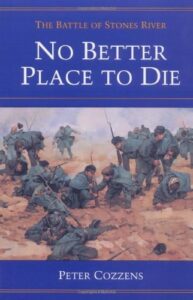To finish off the National Park sites close to us, Tom and I stopped by Stones River National Battlefield on our way from Mammoth Cave back to Cumberland Gap. We had been to Stones River National Battlefield before, but we were there before the Passport program started in 1986, so I didn’t have the stamp.
The Battle of Stones River was a Civil War battle fought from December 31, 1862, to January 2, 1863, in Murfreesboro, Tennessee. Of the major battles of the war, Stones River had the highest percentage of casualties on both sides. The battle ended in Union victory after the Confederate army’s withdrawal on January 3, but the victory was costly for the Union army. Nevertheless, it was an important victory for the Union because it provided a much-needed boost in morale. President Abraham Lincoln‘s issued the Emancipation Proclamation shortly after the battle, which ultimately discouraged European powers from intervening on the Confederacy’s behalf.
Union Major General William S. Rosecrans‘s Army of the Cumberland marched from Nashville, Tennessee, on December 26, 1862, to challenge Confederate General Braxton Bragg‘s Army of Tennessee at Murfreesboro. On December 31, each army commander planned to attack his opponent’s right flank. Bragg had a shorter distance to go and thus struck first.
A massive assault by the corps of Maj. Gen. William J. Hardee, followed by that of Leonidas Polk, overran the wing commanded by Maj. Gen. Alexander M. McCook. A stout defense by the division of Brig. Gen. Philip Sheridan in the right center of the line prevented a total collapse, and the Union assumed a tight defensive position backing up to the Nashville Turnpike. Repeated Confederate attacks were repulsed from this concentrated line, most notably in the cedar “Round Forest” salient against the brigade of Col. William B. Hazen. Bragg attempted to continue the assault with the division of Maj. Gen. John C. Breckinridge, but the troops were slow in arriving and their multiple piecemeal attacks failed.

When night fell on the first day, Bragg was so sure that his army had won that he wired Jefferson Davis about his great victory. He was surprised to see the Union army still on the field when the sun rose the next day. Both sides were too tired from the fighting to resume the battle on January 1. Instead, they used the day to bury the dead and treat the wounded.
Fighting resumed on January 2, 1863, when Bragg ordered Breckinridge to assault a lightly defended Union position on a hill to the east of the Stones River. Chasing the retreating Union forces, the Confederates were led into a deadly trap. Faced with overwhelming artillery, the Confederates suffered heavy losses.
Bragg received information the reinforcements were coming and was fooled by false campfires into believing the Union troops were stronger than he had originally thought. Instead of engaging in battle, Bragg chose to withdraw his army on January 3 to Tullahoma, Tennessee. This caused Bragg to lose the confidence of the Army of Tennessee. The Confederate soldiers were demoralized because they had fought so hard and did not have the victory they expected.
 If you would like more information about the battle at Stones River, you can read this Wikipedia article. Peter Cozzens, my favorite Civil War historian, also wrote an excellent book about Stones River, “No Better Place to Die.”
If you would like more information about the battle at Stones River, you can read this Wikipedia article. Peter Cozzens, my favorite Civil War historian, also wrote an excellent book about Stones River, “No Better Place to Die.”
Tom and I started our visit to Stones River National Battlefield at the Visitors Center. We watched the movie on the battle and spent some time in the museum. The Visitors Center was being run completely by volunteers, which made us feel right at home. We didn’t see a ranger during the entire time we were there.
After checking out the Visitors Center we made a short loop around the battlefield. We saw all the important sites around the battlefield. Hazen’s brigade had the first memorial on the battlefield and stopped to look at that. Unlike Chickamauga and Gettysburg, Stones River does not have a lot of monuments and waysides. They seemed to be less interested in preserving the battle as in preserving the land. The city of Murfreesboro has really grown up around the battlefield.

Tom was eager to get out of town before rush hour, so we didn’t stay long at Stones River National Battlefield. I did, however, find “No Better Place to Die” to be a fascinating treatment of the battle. Having seen the field in person made it even more interesting.

